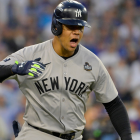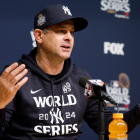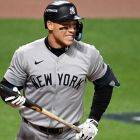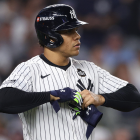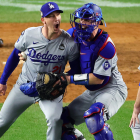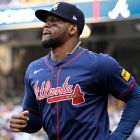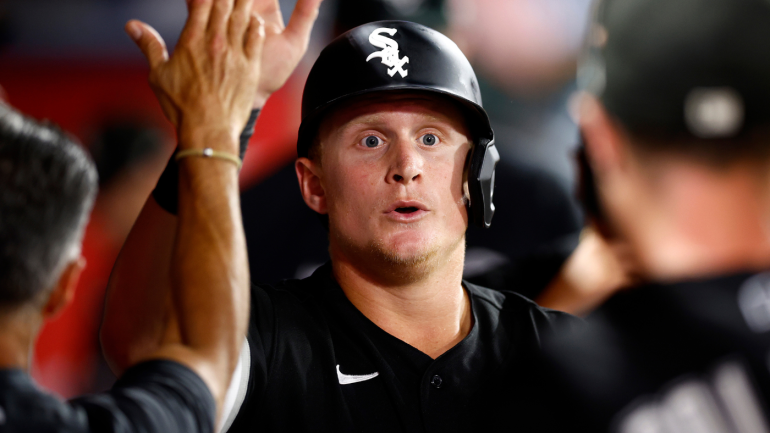
The 2022 MLB regular season is nearly three months old and the contenders are separating themselves from the pretenders. Several teams that started out hot have come back to Earth (like the Angels) and others that started slowly have made a climb up the standings (like the Braves). That said, there's still a lot -- a LOT -- of season to be played.
With that in mind, our weekly series breaking down various trends across the league continues Wednesday with a look a young breakout hitter, one pitcher's unique changeup, and the league-wide increase in catcher interference calls. Last week we looked at two AL Central players who are among the game's best contact hitters, and MLB's plateauing strikeout rate.
Vaughn breaking out with ChiSox
Expected to again contend for the AL Central title, this is shaping up to be a disappointing season for the White Sox. They are 35-38 following Tuesday night's win over the Angels, giving them the same number of wins as the Orioles (35-41). The season is far from over and Chicago still has time to claw back into the race, but this is not where they wanted to be in late June.
One bright spot for the White Sox this season: Andrew Vaughn. The No. 3 pick in the 2019 draft had an underwhelming rookie season a year ago, slashing .235/.309/.396 with 15 homers in 469 plate appearances. A natural first baseman, Vaughn was pushed into the outfield in deference to José Abreu, and it didn't go well. The end result was a replacement-level rookie season (0.2 WAR).
This year though, the 24-year-old Vaughn has been among the White Sox's best hitters, posting a .307/.360/.465 line with seven home runs in 73 team games. He has significantly improved his contact ability as well:
| Vaughn 2021 | Vaughn 2022 | MLB average | |
|---|---|---|---|
Strikeout rate | 21.5% | 17.2% | 22.2% |
Swinging strike rate | 10.0% | 7.9% | 11.1% |
In-zone contact rate | 88.2% | 91.9% | 84.7% |
Nearly 250 players batted at least 400 times in 2021 and have batted at least 200 times in 2022, and Vaughn's year-to-year improvement in those three areas is among the 30 best in the game. Also, Vaughn had better than average contact ability last year! He didn't strike out or swing and miss excessively. Now though, he taken another step forward and is an excellent bat-to-ball guy.
More than anything though, Vaughn's breakout season is the result of his work against right-handed pitchers. The righty swinger crushed lefties last season (.269/.383/.555) and is crushing them again this season (.375/.400/.521). Vaughn had a tough time against righties last year though, particularly hard-throwing righties. This year, it's a different story:
| PA | AVG/OBP/SLG | K% | BB% | |
|---|---|---|---|---|
2021 vs. RHP | 328 | .221/.277/.332 | 21.0% | 6.1% |
2022 vs. RHP | 189 | .287/.349/.449 | 17.5% | 7.9% |
Vaughn is still stuck playing the outfield in deference to Abreu and his defense rates very poorly, dragging down his overall value. He ranks 34th among qualified hitters with a 134 OPS+ but 124th with 0.5 WAR. Nine times in the last 11 games Vaughn has been at DH because of a nagging leg issue, and that's the best spot for him. He and Abreu should share first base and DH duty.
Ultimately, the White Sox did not select Vaughn with the No. 3 pick three years ago for his glove. He's always been a bat-first player and, in his second MLB is season, the bat is really beginning to play. Vaughn posted strong exit velocities as a rookie last year and now he's pairing that hard-hit ability with more contact. That plus his success against righties is a recipe for a breakout season.
(Vaughn's breakout is a reason Tigers fans can be somewhat optimistic about Spencer Torkleson. Torkelson, the No. 1 pick in the 2020 draft, is hitting a woeful .191/.283/.291 this season. He and Vaughn are very similar as righty-hitting first base/DH types, and Vaughn is a reminder that even the most talented hitting prospects can sometimes need a year to figure things out in this league.)
Morgan's unrivaled changeup
A year ago injuries pushed 26-year-old righty Eli Morgan into Cleveland's rotation and he didn't fare all that well: 5.34 ERA with 20 home runs allowed in 89 1/3 innings. Based on the quality of the contact he allowed, Statcast put Morgan's expected ERA at 5.30. It was only 18 starts and many pitchers struggle in their first 18 big-league starts, but Morgan had a rough MLB debut. For sure.
This Guardians opened this season with a healthy rotation, pushing Morgan into the bullpen. And in his new role he is thriving, striking out 43 batters against only six walks in 35 innings. Morgan has worked more than a full inning in 12 of his 21 relief appearances (he did make one spot start in April) and he's becoming a go-to high-leverage option for manager Terry Francona.
Morgan is not a traditional flamethrowing fastball/slider reliever. His fastball is averaging 91.8 mph this year and he hasn't thrown a pitch over 94.5 mph. What makes Morgan stand out is a dead fish changeup that floats in around 75 mph and never seems to get to the plate. He throws it with the same arm action as his fastball and sells the changeup very well.
"He's been outstanding," pitching coach Carl Willis told the Akron Beacon Journal earlier this month. "Everyone on the opposition is always aware of the changeup. Now we're seeing fastballs 93-94. That makes it difficult because he has so much separation in speeds with the change-up and the fastball."
In addition to the drop-off-the-table action, what really makes Morgan's changeup great is the velocity separation with his fastball. He is not a particularly hard-thrower, yet the average velocity gap between his fastball and changeup is the largest in the sport. Here are the biggest fastball/changeup velocity gaps in 2021 (min. 100 of each thrown):
| Average fastball | Average changeup | Separation | |
|---|---|---|---|
Eli Morgan, Guardians | 91.8 mph | 75.4 mph | 16.4 mph |
92.7 mph | 80.1 mph | 12.6 mph | |
Beau Brieske, Tigers | 94.2 mph | 81.7 mph | 12.5 mph |
91.7 mph | 79.5 mph | 12.2 mph | |
Lucas Giolito, White Sox | 93.1 mph | 81.7 mph | 11.4 mph |
MLB average | 93.0 mph | 85.3 mph | 7.7 mph |
Morgan is lapping the field. The 16.4 mph separation between his fastball and changeup is more than double the 7.7 mph league average, and the gap between No. 1 and No. 2 on that list is the same as the gap between No. 2 and No. 31. When it comes to velocity separation between the fastball and changeup, Morgan is baseball's undisputed king.
Thanks to that velocity separation, Morgan's low-90s fastball plays up in a big way. His 32.4 percent fastball whiff rate is sixth best in baseball and puts him alongside super hard-throwers like Gerrit Cole (33.8 percent) and Jhoan Duran (30.8 percent). The radar gun may say 91-92 mph, but the fastball plays more like 97-98 mph because that changeup is so good.
Although they've stumbled a bit the last week or so, the Guardians are very much in the AL Central and wild card races, and Morgan's work as a multi-inning setup man has contributed greatly to their success. He's bridging the gap between the starters and closer Emmanuel Clase, and he's doing it because the gap between his fastball and changeup velocity is so significant.
"It doesn't matter whether he's starting or relieving," bullpen coach Brian Sweeney told MLB.com earlier this month. "He knows what his strengths are. He knows what he has to do when he gets on the mound. He's adjusted really well to the bullpen, and it's pretty cool to see the success he's having."
Catcher interference calls on the rise
Something happened Monday night that hadn't happened in almost two years: there were two catcher interference calls in one inning. Athletics catcher Sean Murphy reached a little too far with his glove and interfered with the swing of Yankees sluggers Aaron Judge and Giancarlo Stanton. A catcher interference is an error on the catcher and the batter is awarded first base.
That was the first time there were two catcher interference calls in the same inning since July 29, 2020, when then-Orioles catcher Pedro Severino interfered with, coincidentally enough, Judge and Stanton. And, sure enough, Murphy was at the plate (not behind it) for a catcher interference call Tuesday night. He's been involved in three catcher interference calls in the last 40 hours or so.
Here are the catcher interference totals the last few years (ignoring the weird pandemic season in 2020):
- 2022: 36 (on pace for 78)
- 2021: 62
- 2019: 61
- 2018: 41
- 2017: 43
- 2016: 41
There were 28 catcher interference calls in 2010 and we're already beyond that number this season. In 2000, there were 19 catcher interference calls all season. So yes, catcher interference is very much on the rise. It is happening way more than in the past.
I'm not sure I'd call catcher interference a skill, but there are some hitters with swings that are conducive to making contact with the catcher's glove because they let the ball travel deep and almost chop down with their swings. Jacoby Ellsbury is the all-time leader with 31 catcher interference calls (he also holds the single-season record with 12 in 2016). Pete Rose is second with 29, though he had nearly three times as many career plate appearances as Ellsbury.
Reds center fielder Nick Senzel is baseball's current catcher interference king. He has six already this season, twice as many as any other player (Padres infielder Jake Cronenworth is second with three). Here is the catcher interference leaderboard since Ellsbury played his final game in 2017:
- Jorge Soler: 14 in 1,997 plate appearances
- Nick Senzel: 12 in 797 plate appearances
- Tommy La Stella: 12 in 1,083 plate appearances
- Jesús Aguilar: 10 in 1,923 plate appearances
- Several tied with 9
Senzel blows everyone else away on a rate basis. Alas and alack, we do not know who leads catchers in catcher interference calls because they go into the books as a fielding error, and we can't separate them from, say, a catcher fumbling a weak tapper out in front of the plate. I assume there's some skill to a catcher avoid catcher interference calls though.
Why is catcher interference on the rise? My theory is it's tied to framing to some degree. Catchers are so focused on presenting the ball well to the umpire that sometimes they get a little too overzealous and reach out too far. It could also have to do with the quality of stuff. Pitchers are really hard to catch now because they throw so hard and have such nasty breaking balls. Catching is not easy and sometimes the catcher is forced to make movements he doesn't want to make just to catch the ball.
Whatever the reason, catcher interference calls are on the rise and we're on pace to set a new single-season record this year. The current record was set last year, and the record before that was set the previous 162-game season. This is definitely a thing now. Catcher interference calls are a relatively small part of the game, but they're a larger part of the game than ever.














